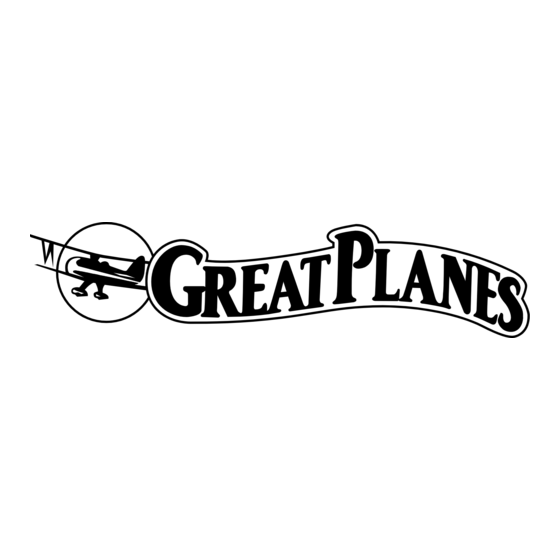GREAT PLANES XPD-8 Manual de instrucciones - Página 13
Navegue en línea o descargue pdf Manual de instrucciones para Juguete GREAT PLANES XPD-8. GREAT PLANES XPD-8 16 páginas.

These are the recommended control surface throws:
High Rate
ELEVON:
1/2" [13mm] up
1/2" [13mm] down
AILERON:
1/2" [13mm] up
1/2" [13mm] down
IMPORTANT: The XPD-8 ARF has been extensively
flown and tested to arrive at the throws at which it flies
best. Flying your model at these throws will provide you
with the greatest chance for successful first flights. If, after
you have become accustomed to the way the XPD-8 ARF
flies, you would like to change the throws to suit your
taste, that is fine. However, too much control throw could
make the model difficult to control, so remember, "more is
not always better."
Balance the Model (C.G.)
More than any other factor, the C.G. (balance point) can
have the greatest effect on how a model flies, and may
determine whether or not your first flight will be
successful. If you value this model and wish to enjoy it for
many flights, DO NOT OVERLOOK THIS IMPORTANT
PROCEDURE. A model that is not properly balanced will
be unstable and possibly unflyable.
At this stage the model should be in ready-to-fly condition with
all of the systems in place including the receiver and ESC.
❏
1. Use a felt-tip pen or 1/8" [3mm]-wide tape to accurately
mark the C.G. on the top of the wing on both sides of the
fuse. The C.G. is located 6-1/8" [156mm] back from the
leading edge of the wing at the fuse. We do not recommend
deviating from the suggested C.G.
❏
2. With all parts of the model installed (ready to fly), place
the model upside-down on a Great Planes CG Machine, or
lift it upside-down at the balance point you marked.
Low Rate
5/16" [8mm] up
5/16" [8mm] down
5/16" [8mm] up
5/16" [8mm] down
13
❏
3. If the tail drops, the model is "tail heavy" and the battery
pack and/or receiver must be shifted to balance. If the nose
drops, the model is "nose heavy" and the battery pack
and/or receiver must be shifted to balance. This model is
very weight sensitive. Do not add any weight to achieve the
suggested balance point. Instead, shift the battery pack and
receiver forward or aft to alter the C.G.
❏
4. Once the proper position is determined, mark the battery
position to insure you place the battery in the same place
every flight. If you change the size of the battery, it will be
necessary to recheck the C.G. and mark the new position.
PREFLIGHT
Identify Your Model
No matter if you fly at an AMA sanctioned R/C club site or if you
fly somewhere on your own, you should always have your name,
address, telephone number and AMA number on or inside your
model. It is required at all AMA R/C club flying sites and AMA
sanctioned flying events. Fill out the identification tag on page 15
and place it on or inside your model.
Charge the Batteries
Follow the battery charging instructions that came with your
radio control system to charge the batteries. You should
always charge your transmitter and motor batteries the night
before you go flying, and at other times as recommended by
the manufacturer.
CAUTION: Unless the instructions that came with your
radio system state differently, the initial charge on new
transmitter batteries should be done for 15 hours using
the slow-charger that came with the radio system. This
will "condition" the batteries so that the next charge may
be done using the fast-charger of your choice. If the initial
charge is done with a fast-charger the batteries may not
reach their full capacity and you may be flying with
batteries that are only partially charged.
Range Check
Ground check the operational range of your radio before the
first flight of the day. With the transmitter antenna collapsed
and the receiver and transmitter on, you should be able to walk
at least 100 feet [30m] away from the model and still have
control. Have an assistant stand by your model and, while you
work the controls, tell you what the control surfaces are doing.
Repeat this test with the motor running at various speeds
with an assistant holding the model, using hand signals to
show you what is happening. If the control surfaces do not
respond correctly, do not fly! Find and correct the problem
